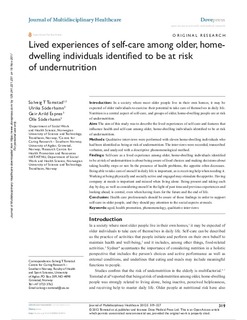| dc.contributor.author | Tomstad, Solveig T. | |
| dc.contributor.author | Söderhamn, Ulrika | |
| dc.contributor.author | Espnes, Geir Arild | |
| dc.contributor.author | Söderhamn, Olle | |
| dc.date.accessioned | 2017-06-07T12:38:53Z | |
| dc.date.available | 2017-06-07T12:38:53Z | |
| dc.date.issued | 2012 | |
| dc.identifier.citation | Tomstad, Söderhamn, Espnes & Söderhamn (2012) Lived experiences of self-care among older, home-dwelling individuals identified to be at risk of undernutrition. Journal of Multidisciplinary Healthcare, 5, s. 319–327. | |
| dc.identifier.uri | http://hdl.handle.net/11250/2445031 | |
| dc.description | Artikkelen rapporterer en studie hvor hensikten var å beskrive erfaringer knyttet til egenomsorg hos eldre, hjemmeboende personer som er identifisert til å være i fare for underernæring. | |
| dc.description.abstract | Introduction: in a society where most older people live in their own homes, it may be expected of older individuals to exercise their potential to take care of themselves in daily life. Nutrition is a central aspect of self-care, and groups of older, home-dwelling people are at risk of undernutrition. Aim: the aim of this study was to describe the lived experiences of self-care and features that influence health and self-care among older, home-dwelling individuals identified to be at risk of undernutrition. Methods: qualitative interviews were performed with eleven home-dwelling individuals who had been identified as being at risk of undernutrition. The interviews were recorded, transcribed verbatim, and analyzed with a descriptive phenomenological method. Findings: self-care as a lived experience among older, home-dwelling individuals identified to be at risk of undernutrition is about being aware of food choices and making decisions about taking healthy steps or not. In the presence of health problems, the appetite often decreases. Being able to take care of oneself in daily life is important, as is receiving help when needing it. Working at being physically and socially active and engaged may stimulate the appetite. Having company at meals is important and missed when living alone. Being present and taking each day by day, as well as considering oneself in the light of past time and previous experiences and looking ahead, is central, even when having fears for the future and the end of life. Conclusion: health care professionals should be aware of these findings in order to support self-care in older people, and they should pay attention to the social aspects at meals. | |
| dc.language.iso | eng | |
| dc.rights | Navngivelse-Ikkekommersiell 4.0 Internasjonal | |
| dc.rights.uri | http://creativecommons.org/licenses/by-nc/4.0/deed.no | |
| dc.subject | pasientsikkerhet | |
| dc.subject | ernæring | |
| dc.subject | underernæring | |
| dc.subject | livskvalitet | |
| dc.subject | helse | |
| dc.subject | mat | |
| dc.subject | drikke | |
| dc.subject | måltid | |
| dc.subject | risiko | |
| dc.subject | forebygging | |
| dc.subject | ernæringsstatus | |
| dc.subject | hjemmeboende | |
| dc.subject | eldre | |
| dc.subject | egenomsorg | |
| dc.subject | egenomsorgsevne | |
| dc.subject | helsefremming | |
| dc.subject | fenomenologi | |
| dc.subject | intervju | |
| dc.subject | Norge | |
| dc.title | Lived experiences of self-care among older, home-dwelling individuals identified to be at risk of undernutrition | |
| dc.type | Journal article | |
| dc.type | Peer reviewed | |
| dc.rights.holder | Tomstad, Solveig T. | |
| dc.source.volume | 5 | |
| dc.source.journal | Journal of Multidisciplinary Healthcare | |
| dc.identifier.doi | 10.2147/JMDH.S38474 | |

